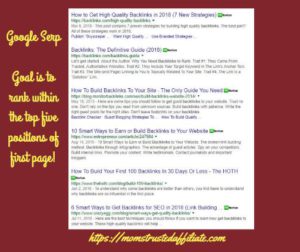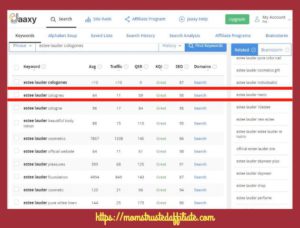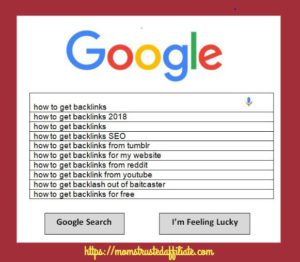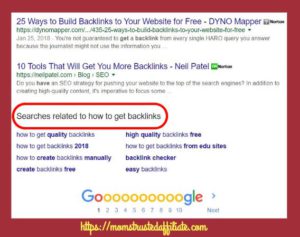Best Way to Do a Keyword Research?
After creating the framework of your website you probably learned about writing content and using keywords to help your posts and pages to rank in Google and other search engines. Many people seem to have trouble researching for keywords at first.
In this article, I will share information that will explain the best way to do a keyword research? More than likely, you have probably gotten a lot of different “tips” about doing keyword research and then apparently tried to wrap them all up into one process. I did that too when I first started.
Today, I’m beginning with the nuts and bolts. So, forget about all the “tips” you got before because I am starting from scratch.

Begin With the Definition
A keyword is usually a word or phrase used in on-page search engine optimization (SEO) that helps our pages and posts rank in Google and other search engines. A keyword tells search engines what your page is all about. Or, you could say that keywords are ideas or topics that define what your content is about for SEO.
To make it even easier to understand; a keyword is a word or phrase the internet users write in the search bar of the search engines such as Google, Bing or Yahoo, for what they are looking for on the internet.
When a user types in a phrase in the search bar (I’ll use Google since it’s usually the “go to” search engine), Google produces a listing of related search results for that keyword entered by the user. We refer to the list as the SERP, (Search Engine Results Page).
We hope that we can locate a keyword or keyword phrase that will put our content on the SERP within the top 5 positions, but at least on the first page. If your pages can rank well in the SERP, it can also bring you organic traffic to your website, and it’s all free.

You can find two types of keywords; head terms (also known as seed words) and long-tail keywords. Head term keywords are usually shorter, one or two words while long-tail keywords are more extended three or more words.
Head term keywords get searched the most, and the topics are broad. That makes them more competitive and more difficult to rank in the SERP. Long-tail keywords are usually more specific with less competition and are straightforward to position higher.
What are the Traits of a Good Keyword?
The basis of a superb keyword is pretty easy to understand, but even so, it may still be difficult to rank for some keywords.
The primary solution to ranking your articles is to:
- Create great original content
- Content must be well written and free of spelling, grammar, and punctuation errors.
- Content must contain information that has value to your audience.

On-Page SEO
You should look for these characteristics in a good quality keyword:
- Use keywords that people honestly use when they search a topic in Google (or whatever search engine you are using).
- The keyword should have a high search volume of no less than 50.
- The competition should be low, no higher than 50.
- Write a great article that you have optimized for the chosen keyword.

The above information is a good guideline to use when searching for a great keyword to satisfy your on-page search engine optimization. However, there can be times when you may decide to deviate a little.
For instance, maybe the competition number is 56, a little over that 50 number. Should you use that particular keyword? If you think your content is good enough to outrank the other 56 websites in the SERP, by all means, go for it.
However, if that competition number is 158, I think you would want to reconsider and find another keyword with less competition. The competition number reveals the difficulty of ranking for that keyword; the higher the number, the tighter it’s going to be to rank for it.
Using a keyword tool like Jaaxy will help you determine which keywords you can rule out due to competition difficulty to rank for those words.

Low Volume and Zero Competition Keywords
What if the search volume is low to none and the competition is zero, you ask? Well, the preference is to use keywords that have the lowest number of competitive websites you can find. With that said, it makes sense because the competition number shows how many sites you are competing against for that keyword.
Think about this: who are you competing with if there is zero competition? Would you be competing with yourself?
I’ve researched this question a great deal, and I still don’t think I have come up with one solid answer because there seems to be a lot of “ifs.” The following is the best information I have found thus far regarding this question.
Changes in the world of marketing to search engine algorithms cause a lot of marketers to start thinking if keyword usage was going to continue as a feasible content strategy. Marketers began to question using keywords because the changes in the algorithms began putting the spotlight more on the importance of conversational queries, likely because marketers are using long-tail keywords.

In previous times, most marketers wouldn’t use long-tail keyword sets as Google frequently branded them with a status of low or no search volume at all. At face value, it appears applying such forms of keywords usually are not worth the work.
More and more marketers are saying otherwise. That’s primarily based on their practical experience, claiming that the use of low search volume search phrases is going to be very good for business.
However, marketers’ opinion is the direct opposite of what most standard SEO techs think, but many other techs claim this as correct. For one particular factor, low volume search phrases have fewer competitors and hence, a lot easier to rank. Thus, this produces more conversions and eventually more profit.
Low Search Volume Search Phrases
A specific keyword or keyword phrase is branded as “low search volume” if it has produced negligible search website traffic based on Google. In Google’s definition, low search volume is “a status that is provided to a keyword with pretty tiny to no search history on Google.”
Because they get marked as possessing a pretty small search history, Google will deem it irrelevant and can set the keyword to an inactive status so it will not trigger your advertisements, especially if you are making use of these search phrases for paid marketing. The issue with using a keyword placed in a dormant state is when a person searches in precise or matching words, your advertisements are not going to show up due to this seemingly damaging label by Google.
What Google recommends for such variety of key phrases is usually to alter them all together and take away it out of your list, or you’ll be able to opt to complete practically nothing and wait for sufficient search volume to trigger the reactivation of this unique low search volume keyword. You are left using the query of no matter whether these keyword phrases really should keep – or should hey go?

It is relatively simple to rank for a keyword that has no competition. However, those type of keywords will not help you rank unless they are related to your website. It is better to employ a relevant keyword that has a low competition number so Google will send some organic traffic to your site.
Also, there may be no competition for the keyword you are trying to rank with, but there still may be a lot of authority sites that are in those top positions, and it is much harder to outrank those types of sites.
It’s a good idea to search the keyword you want to use in Google so you can review the SERP that comes up for that keyword. Paid for ads are always shown first in the SERP. Also, sites that have high authority will generally outrank the smaller websites.
What’s the Rave about Long-Tail Keywords
A long tail keyword is a phrase that consists of three or more words, rather than just one or two words. Another name for long-tail keywords is “low hanging fruit.” The definition of the low hanging fruit is something that is easy to get but doesn’t need much effort.
It is better for small businesses to target long tail keywords right out the gate because these types of keywords have lower search volumes and you can be reasonably confident that they will have less competition as well.
It makes it much easier to rank at the top of the SERP when you use low hanging fruit keywords. Also, long tail keywords are more specific or more targeted than one or two-word keywords (head terms).
People searching with long tail keywords have an excellent idea of what they are looking to find. Targeting with low hanging fruit keywords creates higher conversion rates when used.

Those who search using long-tail are most likely already in the conversion cycle and ready to purchase. Those who search using head terms (one or two words) are more likely just window shopping and not looking to buy.
I’m going to show an instance of a long tail keyword using the keyword research tool that I use on an everyday basis, Jaaxy.
Here is an example of long tail keywords (low hanging fruit):
- Cologne (short tail or “head keyword”) — this is a general keyword and is too broad

The above example is a prime example of why “head terms” are not sufficient to help you rank well in the SERP. There are high numbers of all three criterions. Way too high to try to compete against them.
- Estee Lauder cologne (middle tale) – Narrowed down a bit.

In this example, the keyword may include at least three words, but it is still not narrowed down enough. It needs to be more specific even though it meets two out of three criterions. This keyword still has high competition (QSR).
- Estee Lauder perfume gift sets (long tail) – very targeted keyword

I have outlined two keywords in blue because they are similar to the primary keyword circled in red. However, I chose the keyword circled in red because it was the best out of all the rest because it met all the criteria that I was looking for:
Average Search Volume (AVG) = 50 or higher: The average monthly searches that the keyword receives every month.
Quoted Search Results (QSR) = 50 or less: The number of competing websites ranked in Google for this exact keyword.
Search Engine Optimization (SEO) Grade = High: The score is based on traffic and competition. If the score is high, the more likely you will rank for the keyword on the first page. The score scale is 1- 100: higher equals better.
I personally never use a keyword that has an SEO grade of less than 90, but usually 93 or more.
Notice that the Jaaxy keyword research tool will also give you other possible long-tailed keywords, but the two circled in blue don’t quite make the grade. Here’s why:
- The keyword in the first blue circle wasn’t correctly written. It should be “Estee Lauder perfume gift sets “for” You will need to research the proper wording to see if it is a viable long-tail keyword that can beat out the long-tail circled in red.
To save you time, I checked it out, and it met two out of three criterions. However, it didn’t reach the numbers for the average monthly searches.
- The keyword in the second blue circle has only one small difference from the primary keyword. The word “set” wasn’t written correctly in the singular tense. I checked this one out for you too.
In this keyword, the average monthly search and the SEO grade met the criterions, but the QSR was over 50 for the competition. Therefore, it also did not beat out the primary long-tail keyword in the red circle.
Finding Keywords for Your SEO Content Strategy
The most efficient way to determine what keywords you want to use for your business content is to take the time to brainstorm some wide-ranging topics that you want to rank. Brainstorm as many as you’re able to, but try for 10 to 20 items that pertain to your business or niche.

After you have your topic list, then you can research that list to begin the narrowing down to find more specific keywords that are considered low hanging fruit. To narrow the original list down to particular keyword phrases, think about what your target audience would search for to find your product on the internet.
As you can see in the previous section the examples using the Jaaxy keyword research tool, I used a wide-ranging topic to search, “cologne.” Then I narrowed it down to “Estee Lauder cologne.” Finally, from the narrowed list I was able to find a long tail keyword phrase of “Estee Lauder perfume gift sets.”
Notice how specific my long tail keyword phrase is. Someone entering that particular keyword in the Google search knows precisely what they are looking for and is most likely wanting to purchase that product.
So the steps to keyword research are to:
- Brainstorm as many topics about your business/niche as you possibly can.
- Take those original topics and narrows them down.
- Continue to narrow the topics until you find keyword phrases that fit the criteria of the specific long tail keyword phrases.
Using this process will allow you to come up with lots of keyword phrases that will help you create a lot of content for your website.

What Organic Keywords is Google Giving For Free?
Google is encrypting more and more keywords every day, but until Google no longer uses keywords as a ranking factor, there is another method to locate more specific keyword phrase from your website.
In this method, Google Analytics is your friend. If you check your Google Analytics, you can find information regarding your website traffic assets. You can check out the organic search traffic to see the keywords that people who have come to your site used to get there.

Use Google to Help Find More Keywords
Have you ever noticed that when you are searching for something with Google that as you are typing in what you are looking for in the Google search bar, that a list of words starts to show up under the search bar?

Those phrases are the words used by others that have searched. Many times they may help you locate additional search terms to help you narrow down your topics and can also give you topic ideas for future content.
Another method of Google helping you find additional keywords is by looking at the bottom of the SERP pages. There is usually a list of related searches.

What are Your Chances of Success?
It takes work to figure out which keywords are best to use. You have to figure out what the demand is for any head term or long-tail keyword. You also need to understand that to consistently get high rankings in the SERP much work is involved.
To be successful with keyword targeting, you should continuously monitor and tweak them on a regular basis. It’s a good idea to track the performance of your keywords. Sometimes you won’t be able to rank for a specific keyword even though the criterion shows that is a good keyword to use.
When searching for keywords, your list should be as specific to you, your website, and your business as possible.
I found some fantastic content written by Eric Enge, CEO of Stone Temple Consulting and an SEO consultancy business. The article, “Do You Have a Shot for That Phrase” provides excellent information and examples of why we need to have a better understanding of the relevance to know which keywords we should target.

Generate More Organic Traffic
A way to generate more organic traffic, you need to find that middle ground between the short term keywords (easy to target head terms) and the long-tail keywords (more specific to your business or content).
Organic traffic is a gift from Google.
Get into the practice of monitoring your keywords frequently. I would recommend reviewing keywords at least once every quarter. Some folks like to do it even more often, and that’s okay too. The better rankings you get, the more authority you will gain in the SERP.

Seven Key Locations
Currently, the best practice is to use only one main keyword for each article you write. Some also like to use variations of the primary keywords throughout their content by using synonyms.
Some people have asked me if it’s okay to use the same keyword in different content. My answer to that question is, no! Do you want to have to compete with yourself along with all the other competitors? Of course not, but that is precisely what you would be doing if you use the same keyword in more than one article!
I list here the most critical places where to put your keyword.
- Page Title – Your page title describes what the article is about, and it is the first line seen on your search results. Usually, the page title and the Meta-Title is the same. However, sometimes the Meta-Title can be changed if you want to improve it to gain a better SERP ranking.
Place your keyword as close to the page title as possible; usually within the first paragraph, but definitely within the first 100 words. Make sure that your keyword flows naturally within the content. Never forfeit the readability.
- Meta-Descriptions – This is the information that provides a brief description of your article and located under the title in the SERP results. This section also offers an opportunity to tempt visitors to click on your link.
Meta-Descriptions are no longer a ranking factor in Google anymore. However, it lets Google know whether your content is pertinent to a search term.
- Subheadings – Visitors only scan web pages and therefore, your content should be scannable. Using subheadings will make visitors take a pause there. Placing keywords in here will enable readers to see that your content is significant to what they are searching. You can also use semantic keywords in this area.
- Content – Keyword stuffing must be avoided. Google views overusing the same keyword within content is a method of artificially attempting to inflate rankings.
Example: We sell custom handmade scarves. Our custom handmade scarves are of the utmost quality. Are you considering the purchase of a custom handmade scarf? Contact our custom handmade scarves design department: custom.handmade.scarves@thewebsite.com

-
-
- Images – Search engines index images also, making them an excellent area to put keywords. Be careful of keyword stuffing though!
-
Image File Name
Alt Text
Caption (if used)
URLs – Let Google and your audiences know what your content is about by placing your keyword in the URL.
Anchor Text Links – Links are one of the most significant SEO ranking factors. Use keywords as the anchor text in links. It is important to know that you should vary the anchor text for all types of links; internal and external. Don’t get penalized by Google because of keyword stuffing your anchor text links!
Social Media – Yes! Most people don’t think about using keywords in social media, but it works there too! Understand that user experience, links, and content are important ranking factors.
Social media can make your content much more visible, and by doing so, it strengthens the other ranking factors. Social media will cause more people to connect to your content. The more people that link to it will cause your site to increase its authority, thus increasing the SERP position.
Using Semantic Keywords
Going forward into the prospect of Google’s (and other search engines) ever-changing algorithm “improvements,” we have to get acquainted with the search engines indexing behaviors toward semantic keywords.
When we talk about using semantic keywords, we are talking about the understanding or meaning of a keyword or phrase. For instance, when I enter the single word “coffee” into the search bar, Google wouldn’t know if I was searching for a coffee shop, a coffee table, a coffee grinder, or a myriad of other possibilities for the use of the word “coffee.”
Preferably, rather than using only one word in the search bar, we would include some other supporting words.

Semantics is how we interpret or understand a particular word.
As we write our content, we should use variations of our primary keywords. All that means is that we use synonyms to replace the primary keywords. The definition of a synonym is “a word having the same or nearly the same meaning as another word or phrase.”
The old lady bought coffee. (Primary Keyword)
⇅ ⇅ ⇅ ⇅
The senior woman purchased mocha coffee. (Variation Keyword)
Google and other search engines have expanded their already multifaceted algorithms so that they can recognize that the term “elderly woman purchased” means the same as “old lady bought.” Google is diving deeper into understanding the “intent” of words used in the search bar as well as in content.
Conclusion
It indeed is vital that we keep updated on SEO. We all know that some SEO practices don’t work anymore. The methods used here do work because many marketers are currently using them.
SERP rankings change all the time, but if you can rank within the first five positions, or anywhere on the first page of the SERP, there is a real opportunity for people will choose to select your content.
I always like to be transparent to my readers, so this is the truth of the matter. There is only one slot for the number 1 position in the SERP, and the competition is fierce! Optimizing your website can make a difference which site will gain that regal position.
Research your main keywords and then use variations of those keywords throughout your content, but don’t take away from the effectiveness of the content or mess with the readability of the material.
Above all, remember that you are writing for people, not the search engines! When you have finished your draft, then you can go back and nip and tuck it a little to satisfy your content for SEO.
I suggest you use a reliable keyword research tool that is user-friendly and easy to learn. I use Jaxxy on a daily basis. Check out my Jaaxy review and all the new features added.
Without optimizing, your site will get lost in the sea of millions of other sites out there. Hopefully, you now possess a greater understanding of the best way to do a keyword research, and see the importance of staying on top of your keywords to get to that #1 position in the SERP and to stay there!
Remember that keyword research is the foundation of SEO! At least as of this writing, but you never know if a change in Google algorithms will ever make keywords a non-ranking feature in the future!

I would enjoy hearing about your experience with doing keyword research and if you would like to share any tips that have worked for you with my readers. Also, what is your take on using keywords with zero competition? Drop your comments below in the comment section.
Please feel free to contact me if you need help with anything. Just make a comment below or you can always get in touch with me through wealthyaffiliate.com (here is a link to my profile).
Cheers,
Verna
Founder of Your Trusted Affiliate
momstrustedaffiliate.com
email: verna@momstrustedaffiliate.com
Hi Verna!
You are now my go-to person for everything keywords. I use Jaxxy too but I had no idea of all its benefits. You even helped me to understand better the science of how it all works with rankings. Because of Jaxxy’s info I’ve been able to rank some articles. My question is is it necessary that I upgrade to get better rankings?
Hi Jamie,
So glad you found the article useful. To answer your question — I use Jaaxy PRO, which costs $19 per month. So far, I have now found any reason for me to upgrade to the Enterprise version. However, if you are still using the first 30 searches free, that probably won’t last you much longer. I personally believe that using the PRO version would be sufficient for your current needs if you have a small business. However, even as your business grows, the PRO version will still be a good fit. The Enterprise version is usually for larger scale businesses.
I’m glad I was able to clear some of the cobwebs about keyword research. Keyword research is a never ending process and Google keeps changing those algorithms to throw us a curve ball to keep marketers on their toes!
Thanks for taking the time to stop by and I hope to see you around more. There is always plenty to learn about keywords!
I appreciate your comments! Much success with your business!
Cheers,
Verna
Hey Verna:
Thank you! Whew!
I’ve been tangled up, trying to understand how I’m supposed to use keywords in all of this building, building, building.
Trying to figure it out by getting through all the “tips” and “hacks” and more than very basic basics has been driving me insane.
I bow to you, good lady. You have helped me enormously towards doing this thing better….
Hi Netta,
I understand. There is so much information out there that it can become somewhat confusing and a little overwhelming. It was my intention to simplify things so even a new marketer could understand hoe to do keyword research. When you take away unnecessary stuff, it really is pretty easy to understand.
I’m glad you found the article to be helpful. Let me know if there are any questions you may have. I am glad to help. Wish you much success going forward.
Cheers,
Verna